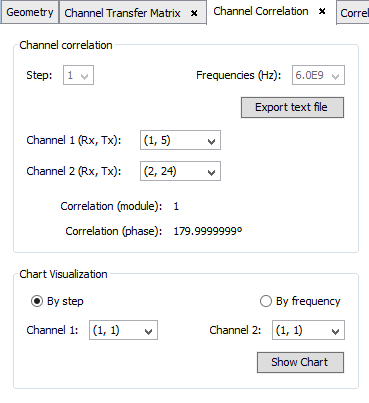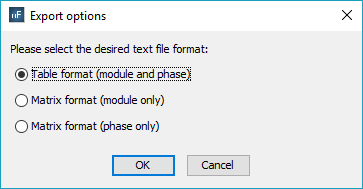Channel Correlation
Selecting the option "Show Results -> MIMO Channel -> View Channel Correlation" will show the following panel:

As with the channel transfer matrix panel, the user can select different steps and frequencies to change the shown results (if there is only one step or one frequency in the simulation, the drop-down list will be grayed out).
The "Channel 1 (Tx, Rx)" and "Channel 2 (Tx, Rx)" drop-down lists allow the user to select the two channels for the visualization of their correlation. Each channel is defined by the index of its transmit (Tx) antenna and the index of its receiving (Rx) antenna. If the user selects two different channels, the geometry panel will highlight their antennas and draw a blue line connecting the antennas of the first channel, and a red line connecting the antennas of the second channel. As in the "Channel Transfer Matrix" panel, transmit antennas are red-colored while receiving antennas are purple-colored.
It is also possible to draw a plot of a specific element of the correlation matrix by step or frequency. To do this, the user needs to select whether they want to draw a plot by step or by frequency, select the two channels and press the "Show Chart" button. Doing this will open the Plot Viewer with the selected plot (refer to GUI for more information about Plot Viewer functions).
For each combination of step and frequency, the user can export a text file with the values of the correlation matrix. Pressing the "Export text file" button will show the following window:

In this window, the user needs to the select the format of the generated text file. There are three different options:
- Table format (module and phase): Generates a text file with its contents arranged in a table. Each row of the table contains the Channel 1 and Channel 2, each one defined by its transmit antenna (Tx) index and receiving antenna (Rx) index; and the module and phase of the correlation for those channels.
- Matrix format (module only): Generates a text file with only the modules of the correlation values. These values are displayed in a matrix format C lines, with each line containing C space-separated values (where C is the total number of channels).
- Matrix format (phase only): The same as the previous format, but the phases of the correlation values are written (instead of the modules).
After selecting the format, the application will show a window in which the user needs to select a location for the text file on their hard drive. The file will be exported to the selected location.